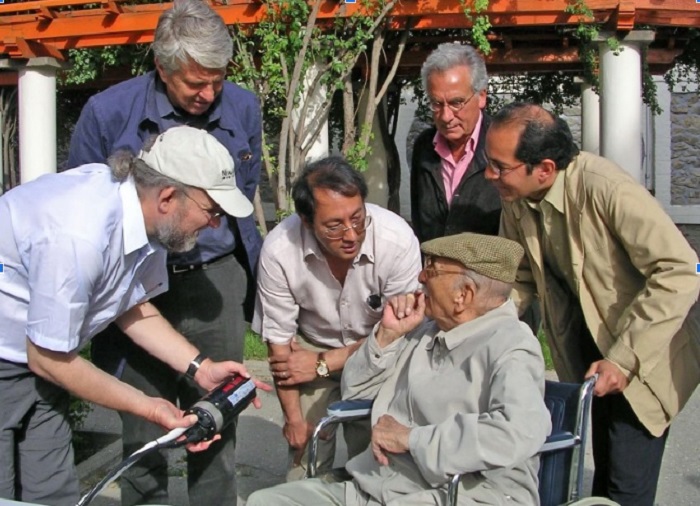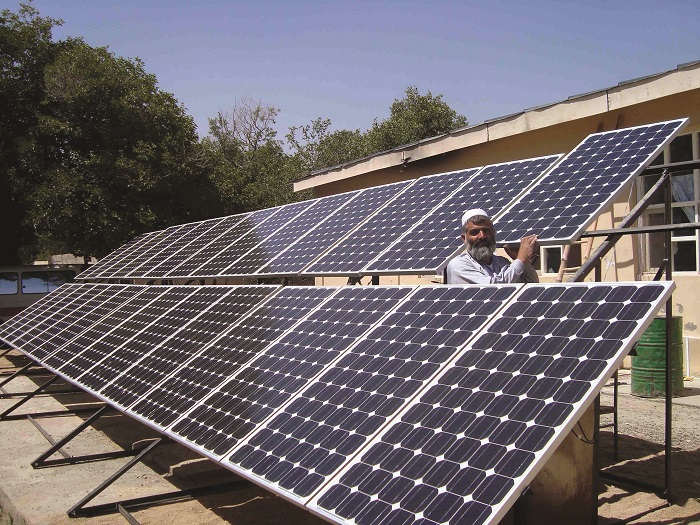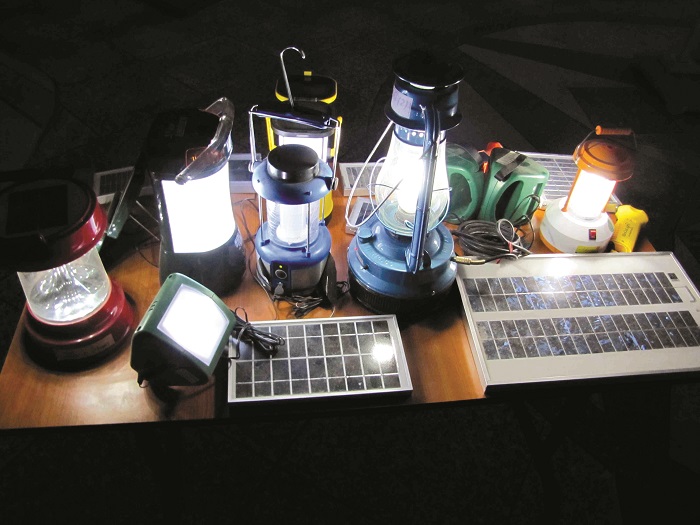By Robert Foster September 25, 2022

The author explaining how a solar water pump works to Afghan King Mohammed Zahir Shah and his son at the royal palace in 2006 along with the Italians. (Credit: Robert Foster)
Renewable energy systems are often the most reliable options for supplying consistent power in conflict and war zones due to the systems’ decentralized nature. Onsite solar power systems — and mini-grids in particular — can save lives in many ways. They power health clinics and hospitals that care for the wounded. They quietly power security perimeter sensors and cameras as well as onsite security lighting. They reduce the need to truck in expensive fuel across dangerous roadways that are subject to attack. They can safely purify available water onsite. And they inform the local populace about relevant news, events and announcements.
Working in a conflict zone has unique challenges that can vary, as I have learned from working in Guatemala during the civil war, Chiapas during the Zapatista uprising, Chihuahua during the narco wars, and Afghanistan. I’ve also experienced repressive dictatorships such as in Pinochet’s Chile, Stroessner’s Paraguay, Ortega’s Nicaragua (both times) and Castro’s Cuba. I have been fortunate to have barely missed several major terrorist attacks like the al-Shabab Westgate Mall attack in Nairobi. (I had lunch there twice that same week.)
I first came to Afghanistan in 2006 while working at New Mexico State University supporting an Italian client on some early solar capacity-building activities. I had the opportunity to conduct a solar pilot demonstration for the last king of Afghanistan, Mohammed Zahir Shah, at the royal palace. He was a humble man who was always a big supporter of solar energy for his country and was generally well liked by the Afghan people. The royal family went into exile in Italy while abroad in 1973 after the Daud coup. The Italian sponsor was a well-heeled billionaire client who proved to be a mafioso who didn’t like to pay his bills.
I later lived in Afghanistan from 2008-2012, implementing solar projects first as deputy chief of party of the United States Agency for International Development Afghanistan Water, Agriculture and Technology Transfer Project for the New Mexico State University College of Agriculture. Then later, I was the chief engineer for the USAID Afghanistan Clean Energy Program for IRG and Winrock International, where I also served as the WI country manager.
ACEP was a $22-million program primarily focused on solar energy. It has been the single largest USAID-funded solar energy initiative to date. WI provided engineering technical support. The primary activity was the installation of photovoltaic systems for villages in 21 Afghan provinces.
Some of the provinces were quite dangerous. In a few instances, work crews were kidnapped by Taliban or jailed by corrupt local authorities, but all were fortunately released unharmed. Some PV systems in the south experienced theft or sabotage.
Many rural Afghan people typically live in small villages, often scattered over challenging mountainous terrain. There is little likelihood for many of them to ever receive electricity from the national grid. Only through solar or micro hydropower technologies can many of these rural Afghan villages hope to enjoy basic electrical service.
Working in a conflict zone obviously has its own risks. Psychologically, it is difficult. Not everyone is up to the challenge. I saw several colleagues literally go bonkers living in a security straitjacket. You also need to take responsibility for your own security even if you have a security detail and know when to say no. This saved me from at least one kidnapping in Wardak. Unfortunately, the driver they sent was kidnapped.
You should never take on any war-zone assignment just for a nice paycheck. It was generally said that there were four types of people who came to work in a war zone like Afghanistan: missionaries, misfits, mercenaries and mofos. I fell into the first category. My local colleagues affectionately called me the “solar mullah.”
Your perspective on what matters in life changes after you have faced the risk of being blown up, shot at, stabbed, clubbed and stoned with rocks.
I’ve had to deal with staff and work crews being kidnapped as well as myself once in Mexico.
Several colleagues in Afghanistan were murdered or died during bungled rescue attempts. Fortunately, I never lost a staffer. It would be heartbreaking to unknowingly send someone to their death by hiring them.
Since 90% of suicide bombings were in the morning, meetings in Kabul were generally scheduled in the afternoon to minimize risks. The going pay scale for suicide bombers was about $25,000 — paid out to their survivors.
As the lead technical guy, I was often the first to spot corruption and alert superiors when shady colleagues were taking kickbacks or stealing hardware or cash. One U.S. colleague ended up doing prison time in Huntsville as a result. Others returned the hardware to avoid prison. And yet others covered their tracks well enough and got away with it.
Nothing hits you harder than an outright betrayal by a trusted staffer you have worked with for several years.
One challenge to working in a conflict zone is that you are typically in a living situation with your coworkers. Imagine living with your coworkers 24/7, sometimes with shared bathroom facilities. There’s nothing like seeing your boss in their skivvies first thing in the morning!
You have to be diplomatic. You should be careful not to bring work issues home and also not to bring home issues to work.
As I told one female colleague from Mexico, you receive extra pay not really because of the risks, but because of the fact that you have to live with a bunch of whiny 40-to-70-year-old males who never learned how to take care of themselves. I am sure I never want to live in a retirement home.
As far as project implementation is concerned, logistics is often the biggest challenge in conflict zones. Everything costs more than it normally would. Should you take an armed security detail? Is it better to fly under the radar and go local?
Once, while setting up a meteorological tower in Parwan about 20 miles north of the Bagram Airfield, we had a visit from the U.S. Army, which circled us in two helicopters to make sure we were not setting up a Katyusha rocket launcher.
Fortunately, I had remembered the experience of a colleague in Lebanon who had a similar issue with the Israeli military while setting up a meteorological tower. So I had all the staff wear orange construction vests and yellow hard hats. I had our armed escort keep their firearms out of sight inside the vehicles. So we gave friendly waves and the military guys circling above waved back and went on their merry way.
There are special challenges to importing hardware to a landlocked, war-torn country like Afghanistan. It took over a year to ship in six meteorological towers. They were stuck in Pakistani customs. They required 33 signatures for release (one of which was in the wrong place and had to be redone). They also required excessive warehousing fees. The fees encouraged customs to move slowly.
But I was lucky. Some colleagues would eventually import a “sealed” container through Pakistani customs only to find that the contents had been stolen and it was now filled with dirt and rocks.
Solar Health Clinics
We electrified 32 clinics with PV systems in a dozen Afghan provinces. We also provided each clinic with a solar hot-water system. These health clinics typically serve over 200 patients per day. The system powers autoclaves, ventilators, microscopes, electrocardiograms, ultrasounds, infant warmers, and other medical equipment. It also powers lights and computers.
ACEP worked in collaboration with the Afghan Ministry of Public Health. The average solar clinic was saving about $500 a month in avoided generator fuel. Often, these clinics were the only sources of electrical power in their communities, so many community members also used them to charge mobile phones.
Each clinic was also provided a DC refrigerator for vaccines.

Solar Schools
Our program electrified rural schools in Afghanistan. This included installation of two 2-kWp PV systems with inverters on coed schools in Yawkaland District near Band-e Amir National Park in Bamiyan.
These systems power lights, computers, projectors and more. They were installed at the request of the USAID Bamiyan Provincial Reconstruction Team in cooperation with the Wildlife Conservation Society.
Additional schools were electrified in Nuristan, powering computer laboratories for both adjacent boys’ and girls’ schools.
As sometimes is the case with development projects, there can be unintended consequences. We also provided some solar streetlights on the road intersection leading to a school. The Taliban quickly used them to conduct target practice at night from the nearby local police station. We had to quickly remove those particular solar streetlights to avoid unintended casualties.

Solar Streetlights
We installed 735 solar streetlights throughout the country. Unlike previous solar streetlights used in Afghanistan that typically only lasted for a few months due to poor design and hardware, the ACEP solar-streetlight systems used 50% more solar and battery storage while providing 1/3 more light than those previously deployed in Afghanistan by previous projects.
The earlier lighting typically had failed within months due to using shallow-cycle batteries. The teams had the “lowest bid” procurement instead of the “best offer.” Most of the ACEP solar streetlights lasted about seven or eight years on average before the first battery replacements were required.
ACEP also served as a test bed for some early demonstration pilots using Japanese solar streetlights that use lithium-ion ultracapacitors that should provide over 50,000 hours of service before any replacements are needed.
These were installed at schools in Bamiyan and Nuristan. The last assessment conducted in 2019 showed that these streetlights were still working well after a decade despite frigid winters (often -20°F).
Solar Water Pumps
The program installed over two dozen PV water-pumping systems, with half of these in Nangarhar Province and the rest in Balkh, Bamiyan, Kapisa and Parwan. These pumps are mostly for school and community water-supply systems.
These direct-drive PV systems use high-quality AC pumps and should provide 20 or more years of useful service. They were used ostensibly for community water supply, but also often provided badly needed water for small-scale irrigation of farm plots.
The systems typically pumped from 25 to 40 cubic meters of water per day.
Typically, the most difficult part of the project was the ~10-month-long inefficient customs-clearance process at the port of Karachi in Pakistan.

Solar Home Systems
Our team installed over 700 small solar home systems for seven villages in Khost Province. These newer systems represented a significant improvement over past systems installed in Afghanistan. Most of the earlier systems were plagued by problems due to undersized solar panels, inappropriate batteries such as ones for automobiles and undersized wires. The Ministry of Rural Rehabilitation and Development had prohibited PV systems in its programs as a result.
When I first arrived to work in Afghanistan in 2008, I was consistently told that PV did not work due to poor-quality Chinese PV modules. I finally convinced MRRD to take me out to some of these problem systems. The first thing I noticed is that they were using Japanese Kyocera modules. Their problems were systems-related and had to do with poor module tilt, wrong orientation, car batteries with shallow cycles, and undersized wires with high voltage drops across long wire runs.
We introduced quality systems through our new programs and capacity building.
Solar Lanterns
Our program provided over 10,000 solar lanterns for different nomadic tribal people in Afghanistan. This included over 1,700 solar lanterns in Badakshan.
These small systems are used to assist rural nomads in Afghanistan with basic LED light to replace kerosene lamps and to provide an option for mobile phone charging.
ACEP distributed more than 1,600 of these lanterns to villagers in Kirghiz and Wakhi nomadic communities in the Badakshan province’s Wakhan Corridor. We worked in collaboration with the Wildlife Conservation Society. Additional lanterns were provided to the Kuchi people in eastern Afghanistan.

Solar Mini-Grids
One of the world’s largest solar mini-grids was installed for Bamiyan in central Afghanistan in 2013. The 1-MWp PV/diesel hybrid mini-grid was installed by Sustainable Energy Services International for the New Zealand Ministry of Foreign Affairs.
I served as the commissioning engineer for this system in 2013. The installation began in 2012, with the system beginning operation in late 2013. The total project cost was $14.1 million, including all transmission and distribution lines and capacity building. After construction, the system was turned over to Da Afghanistan Breshna Sherkat, the national utility company.
SESI maintained close contact with the community, soliciting opinions and asking for support in construction and monitoring. All of the local laborers were hired from communities near the power-plant sites. Consumers use prepaid pay-as-you-go cards to purchase kWh.
Capacity building centered on educating DABS about how to operate and maintain the plant. In addition to the engineers, clerical and management staff were trained in how to properly manage an electrical distribution system, customer connections and an accurate accounting system.
Building Capacity
The cornerstone of any successful solar-development program is building capacity to develop local expertise. In particular, ACEP focused on long-term capacity-building at universities and technical institutes in collaboration with different ministries – particularly the Ministry of Energy and Water and MRRD.
ACEP also worked to establish the KURE Laboratory for systems test and evaluation. Project installations also served as a means for training local technicians on good PV-system design and installation practices and educating communities about solar power.
Our program was the first to introduce high-quality PV systems and a national PV electrical standard to Afghanistan. This helped improve the overall quality and reliability of PV systems.
Many earlier PV systems deployed in Afghanistan had experienced widespread failures due to poor design and installation practices. MRRD had installed over 100,000 PV home systems, almost all of which had early failures to the point that MRRD had banned the use of PV systems in its development programs. These issues were due to sizing, design and installation problems.
These types of errors were often found with international donor projects, which typically relied on inexperienced local suppliers for technical guidance regarding PV-system design and awarded bids based on the lowest price. This practice encourages undersized and substandard systems that are designed to fail. Most of the sponsors did not have any in-house expertise or understanding of detecting poor-quality PV design or installation.
We developed a national solar guideline which revolves around application of an Afghan National Electrical Code for design and installation. We also educated the Afghan rural-development agencies on what a properly sized and installed quality PV system looks like. We wrote a comprehensive national solar guideline and standard adopted by MEW/MRRD.
Solar program success ultimately depends on local capacity building for engineers, technicians and suppliers. Greater technical capacity of suppliers leads to better-quality systems and greater consumer confidence.
Program partners, including industry, learned about correct PV-design approaches through workshops and seminars. They also learned how to perform technical-acceptance tests of installed systems.
Many of the KURE Laboratory graduates now form the core of today’s Afghan solar industry. It remains to be seen what will happen with the lab and what opportunities will remain for women’s solar education now that the Taliban are back in control.

About the Author
Robert Foster is an international renewable energy expert with over 35 years of experience in 44 countries. He has supported dozens of international renewable energy development programs for the U.S. Department of Energy, United States Agency for International Development, the World Bank, Asian Development Bank, United Nations Development Programme, the National Aeronautics and Space Administration, the National Renewable Energy Laboratory, the National Science Foundation, Sandia National Laboratories, and several national governments. He is the chair of the American Solar Energy Society Board of Directors.
Online Note: A Technician’s Story
Shafiqa Jamal Yahyazada said in an email sent by her daughter to Solar Today that she is “one of the women who’s fought with life and in a society like Afghanistan to achieve her goals and improve herself.”
She said she participated in a solar training funded by the German Technical Corporation and the MEW from 2006 to 2007. The program included solar energy, business management, basic English and computer science. She earned a grade of 95% on her final exams.
In 2010, she said, she joined SESI. She was there for 2.5 years, working in different parts of Afghanistan such as Kabul Province, Panjshir Province, Herat Province and Bamyan Province.
Now, she lives in Auckland, New Zealand with her children. She said she wants to continue her solar work.
Regarding women’s participation in the solar industry, she said, “There are companies that are outright expressing an interest in women, but I do think it’s a culture change, like how job descriptions are written and who actually is going out and representing companies in the recruitment process. It matters. There are plenty of women who are interested in solar; we just have to do a better job of getting them involved.”




